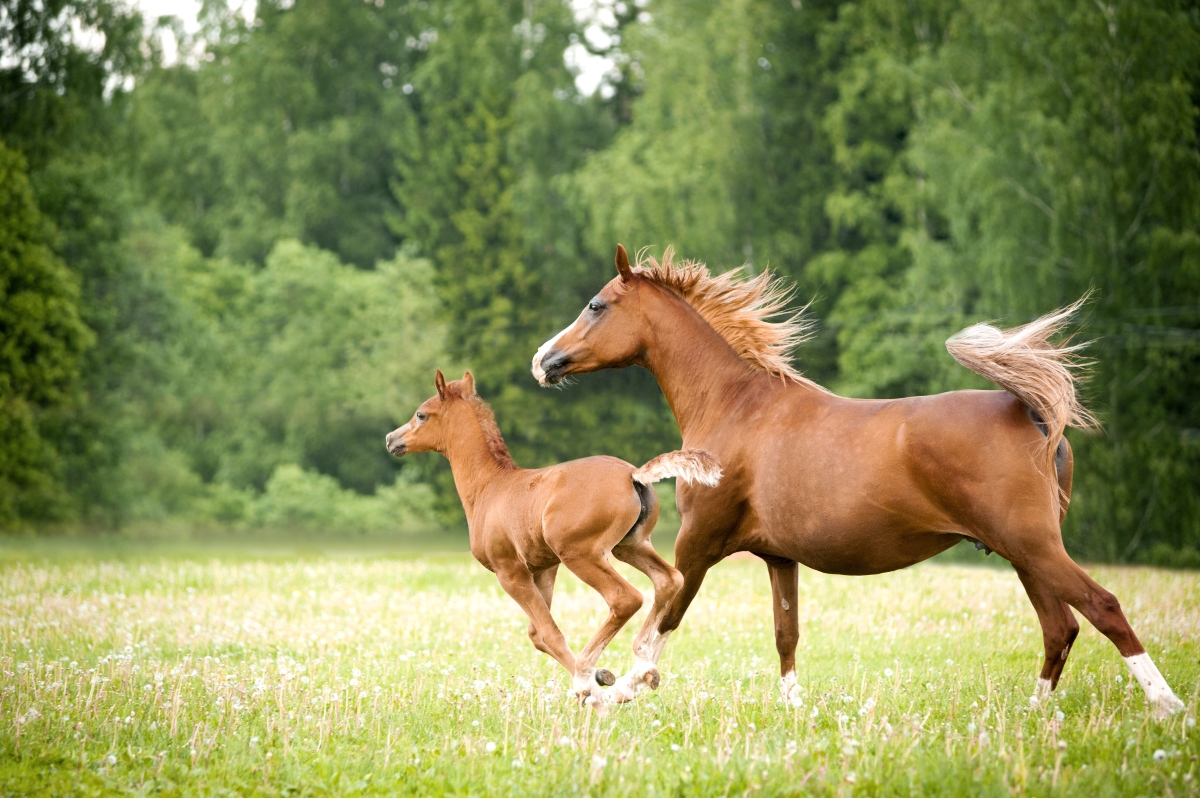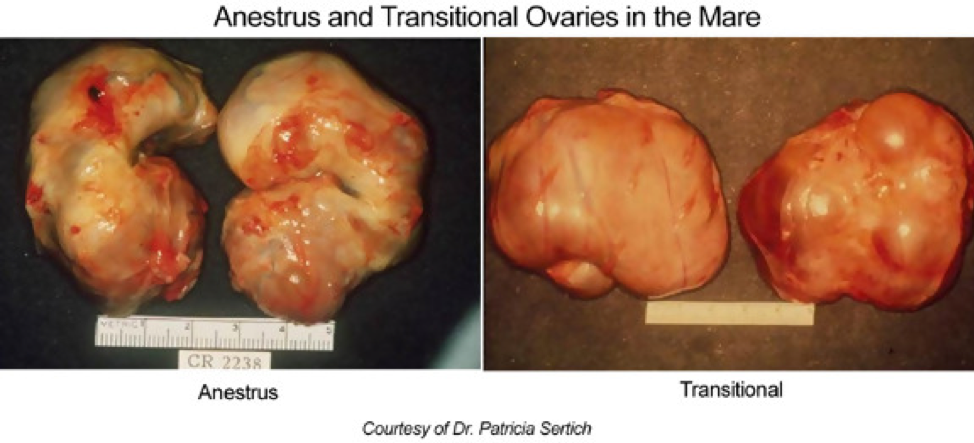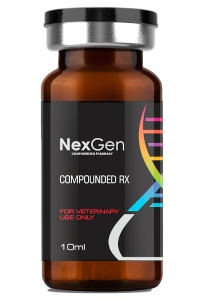Receptive Estrous Cycles in Mares
 Mares
are seasonally polyestrus, meaning that they experience regular estrus cycles
during late Spring, Summer and early Fall, and none during the Winter. These
cycles are controlled by hormones, which respond to increases or decreases in
daylight duration with the onset of the seasons.
Mares
are seasonally polyestrus, meaning that they experience regular estrus cycles
during late Spring, Summer and early Fall, and none during the Winter. These
cycles are controlled by hormones, which respond to increases or decreases in
daylight duration with the onset of the seasons.
The typical mare cycles regularly between March and October, with each estrous period being an average length of twenty-one days.1
Anestrus is seen during the winter when daylight length is short. During anestrus, the uterus is flaccid, and the ovaries are inactive with no significant follicles or corpora lutea. The cervix may be closed but not firm and tight, or it may be thin, short, and dilated. As the length of daylight increases, mares undergo a vernal transition and the ovaries become active, with numerous large (>25 mm) follicles. The cervix and uterus have minimal tone. Mares have three or four prolonged intervals of estrus (periods of sexual receptivity to the stallion) during the vernal transition, but ovulation does not occur.2

Estrus, or heat, is the period of the reproductive cycle when the mare ovulates and, if bred, is likely to conceive. Estrus is also the time when the mare is receptive and will accept the stallion. The average length of the estrous cycle, or the period from heat period to the next heat period, is 21 days, but the estrous cycle can vary from 19 to 26 days. The duration of estrus is five to seven days (actually about six days), but it can vary from two to 10 days. The first heat following foaling is referred to as foal heat. Foal heat typically occurs six to nine days after foaling, but it may be as early as five days or as late as 15 days.3
According to Dr. Sertich and the bulk of the literature, mares have two follicular waves each cycle.
The first wave of follicular development occurs during diestrus, and these follicles become atretic. The second wave occurs after luteolysis and is associated with estrus. Early in estrus, the endometrial folds of the uterus are edematous, but the edema wanes as ovulation approaches. Usually, one follicle becomes dominant and ovulates when it is ≥30 mm in diameter. The dominant follicle enlarges and then softens just before ovulation. The oocyte is released through the ovulation fossa. A corpus hemorrhagicum and subsequent corpus luteum form and produce progesterone, which stimulates closure of the cervix and an increase in uterine tone. This corpus luteum will be mature and become responsive to prostaglandin in ~5 days. If pregnancy is not established, luteolysis occurs at 14 days, and the mare returns to estrus and continues to cycle.2
Artificial Manipulation of the Photoperiod
Horses are referred to as “long-day breeders” because they come into heat as the days increase in length in the spring. Mares are also “seasonally polyestrous,” meaning they have multiple estrous cycling throughout the spring and summer.3 As mentioned elsewhere in the literature, horse owners and managers often have a need to regulate mares' estrous cycle for reasons relating to behavior and breeding. In these cases, manipulation of the light cycle is one of the methods used in this pursuit.
After winter anestrus and the vernal transition, cyclicity naturally starts sometime in the spring, when breeding can begin. Because changes in the mare’s genital tract are seen in response to the length of daylight, the onset of ovulation and subsequent regular estrous cycles—and thus, the onset of the breeding season—can be hastened by exposing the mare to 16 hr of light per day; 8–10 wk are required for mares to respond. If the breeding season is scheduled to begin February 15, mares should be exposed to daily supplemental artificial lighting starting on December 1. The supplemental light must be added at dusk; light added in the morning before dawn is not effective.2
Regulation of Ovarian Activity
There are a number of situations in which it is desirable to suppress part or all of the reproductive endocrine system in a horse, notably the competing animal whose tractability during training, or performance during competition, is compromised by the expression of sexual or aggressive behavior.4 The most effective methods in this regard involve chemical agents (medications and synthetic hormones).
Ovarian activity is frequently manipulated by administration of hormones to facilitate scheduling of breeding appointments and to limit the number of breedings per estrus. Breedings should be spaced for stallions with large books of mares so that semen use is optimized. Geographic locations and transportation constraints may also necessitate scheduled breedings. Many situations can benefit from an ovulation control program.2
 Detection of
Estrus
Detection of
Estrus
Frequent palpation and ultrasonography of the genital tract, excellent record keeping, and administration of hormones allow veterinarians to intensively monitor and manipulate a mare's estrous cycle.2 Breeding management can be optimized however, if a good estrus detection program is in place. A mare detected in estrus will prompt the breeding farm manager to examine and prepare the mare for breeding. Estrus may be the first indication that a pregnant mare has experienced early embryonic death or an abortion.
Teasing systems are among the most widely-used methods for detecting estrus in mares. These typically involve presenting stallions to intact mares and quantifying the observations made through scoring. Teasing and scoring systems vary dependent upon the number of mares at a given location, as well as the mare's history and overall temperament.
Equine Breeding Products
You can find equine breeding products in our online store. Login to your account to view prices and purchase or create an account. Please note you must have a valid veterinarian license to create an account. If you do not, please forward our information to your veterinarian.
2Peterson, M., DVM. Clinical use of Gonadotropin-Releasing Hormone (GnRH) Agonists in Companion Animals: An Overview, Insights into Veterinary Endocrinology, Jan. 2015.
1Kuhns, B. Brood Mare Management, Modern Veterinary Practice, Volume 55/Number 5, p.359, May, 1974.
2Sertich, P., DVM. Reproductive Cycle in Horses, Merck Veterinary Manual, 2019.
3Griffin, A. Horse Breeding Behavior, New Technologies for Agriculture Extension grant no. 2015-41595-24254 from the USDA National Institute of Food and Agriculture, July, 2019.
4Stout, T.A.E., Colenbrander, B. Suppressing reproductive activity in horses using GnRH vaccines, antagonists or agonists, Animal Reproduction Science, Volumes 82–83, July 2004, p. 633-643.
About NexGen Pharmaceuticals
NexGen Pharmaceuticals is an industry-leading veterinary compounding pharmacy, offering sterile and non-sterile compounding services nationwide. Unlike other veterinary compounding pharmacies, NexGen focuses on drugs that are difficult to find or are no longer available due to manufacturer discontinuance or have yet to be offered commercially for veterinary applications, but which still serve a critical need for our customers. We also specialize in wildlife pharmaceuticals, including sedatives and their antagonists, offering many unique options to serve a wide array of zoo animal and wildlife immobilization and anesthesia requirements.
Our pharmacists are also encouraged to develop strong working relationships with our veterinarians in order to better care for veterinary patients. Such relationships foster an ever-increasing knowledge base upon which pharmacists and veterinarians can draw, making both significantly more effective in their professional roles.



